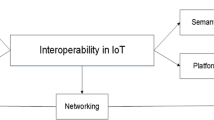Abstract
Increasing popularization of mobile devices has pushed emergence of new services and technologies with convergence of broadcasting and broadband. One of the most striking issues of hybrid broadcasting is synchronization of delivered data over a heterogeneous network. Therefore, we consider a method of synchronization for delivery of hybrid content, as well as between devices using different service platforms. A hybrid delivery architecture and synchronization algorithm for heterogeneous networks in an inter-device environment is developed. In an inter-device system with broadcasting and broadband networks, experimental results verify that the proposed algorithm achieves accurate synchronization performance.







Similar content being viewed by others
References
P. Orero C. Alberto et al. (2015) HBB4ALL: deployment of HbbTV services for all, IEEE International Symposium on Broadband Multimedia Systems and Broadcasting pp. 1–4
S. Aoki, K. Aoki, H. Hamada et al. (2011) A new transport scheme for hybrid delivery of content over broadcast and broadband, IEEE International Symposium on Broadband Multimedia Systems and Broadcasting pp. 1–6
Malhotra R (2013) Hybrid broadcast broadband TV: the way forward for connected TVs. IEEE Consum Electron Mag 2(3):10–16
P. Podhradsky (2013) Evolution Trends in Hybrid Broadcast Broadband TV, 55th International Symposium ELMAR, pp. 7–10
Baba A, Matsumura K, Mitsuya S et al (2012) Seamless, synchronous, and supportive: welcome to Hybridcast: an advanced hybrid broadcast and broadband system. IEEE Consum Electron Mag 1(2):43–53
ISO/IEC 23008–1 (2014) Information technology—high efficiency coding and media delivery in heterogeneous environments—Part 1: MPEG Media Transport (MMT), June
Y. Kawamura, K. Otsuki et al.(2016) Functional evaluation of hybrid content delivery using MPEG media transport, IEEE Int Conf Consum Electron, pp. 239–240
B. S. Kim, S. J. Hahn, J. M. Kang et al (2012) World’s First Hybrid 3DTV Broadcasting Experiment, IEEE Int. Symp. On Broadband Multimedia Systems and Broadcasting, pp. 1–5
C. Kohnen, C. Koble, N. Hellhbund (2012) A DVB/IP streaming testbed for hybrid digital media content synchronization, IEEE International Conference on Consumer Electronics -Berin, pp.136–140
K. Matsumura, M. J. Evans et al. (2010 ) Personalization of broadcast programs using synchronized internet content, IEEE Int Conf Consum Electron, pp.145–146
M. Onishi, Y. Hironaka, et al.(2016) Multi-screen broadcast-broadband synchronization system using Hybridcast, IEEE Int Conf Consum Electron, pp.423–424
C. Kohne, N. Hellhbund, J. Renz, J. Muller (2013) Inter-device and inter-media synchronization in HBB-NEXT, MediaSync2013
C. Howson, E. Gautier, et al.(2011) Second screen TV synchronization, IEEE International Conference on Consumer Electronics -Berin, pp. 361–365
M. Vandenberghe, M. Matton et al. (2013)Synchronisation between First and Second Screen based on Timecode Streaming. MediaSync2013
ISO/IEC 13818–1 (2010) Information Technology-Generic Coding of Moving Pictures and Associated Audio Information: Part 1 System, retrieved
Sodagar I (2011) The MPEG-DASH standard. IEEE Multimed 18(4):62–67
Mills DL (Oct. 1991) Internet time synchronization: the network time protocol. IEEE Trans Commun 39(10):1482–1493
J. M. Valin, G. Maxwell, T. B. Terrriberry, and K. Vos (2013) High-quality, low-delay music coding in the OPUS codec, AES 135th convention
Tsai MF et al (2011) Forward error correction with interleaving mechanism combining cognitive Technology for video streaming over wireless networks. ISWPC 2011:1–6
Acknowledgements
This research was supported by Basic Science Research Program through the National Research Foundation of Korea(NRF) funded by the Ministry of Education(NRF-2016R1D1A1B04934750).
Author information
Authors and Affiliations
Corresponding author
Rights and permissions
About this article
Cite this article
Kim, TJ., Kim, CK. & Kim, BG. An efficient hybrid delivery technology for a broadcast TV service. Pers Ubiquit Comput 22, 135–141 (2018). https://doi.org/10.1007/s00779-017-1059-4
Received:
Accepted:
Published:
Issue Date:
DOI: https://doi.org/10.1007/s00779-017-1059-4




